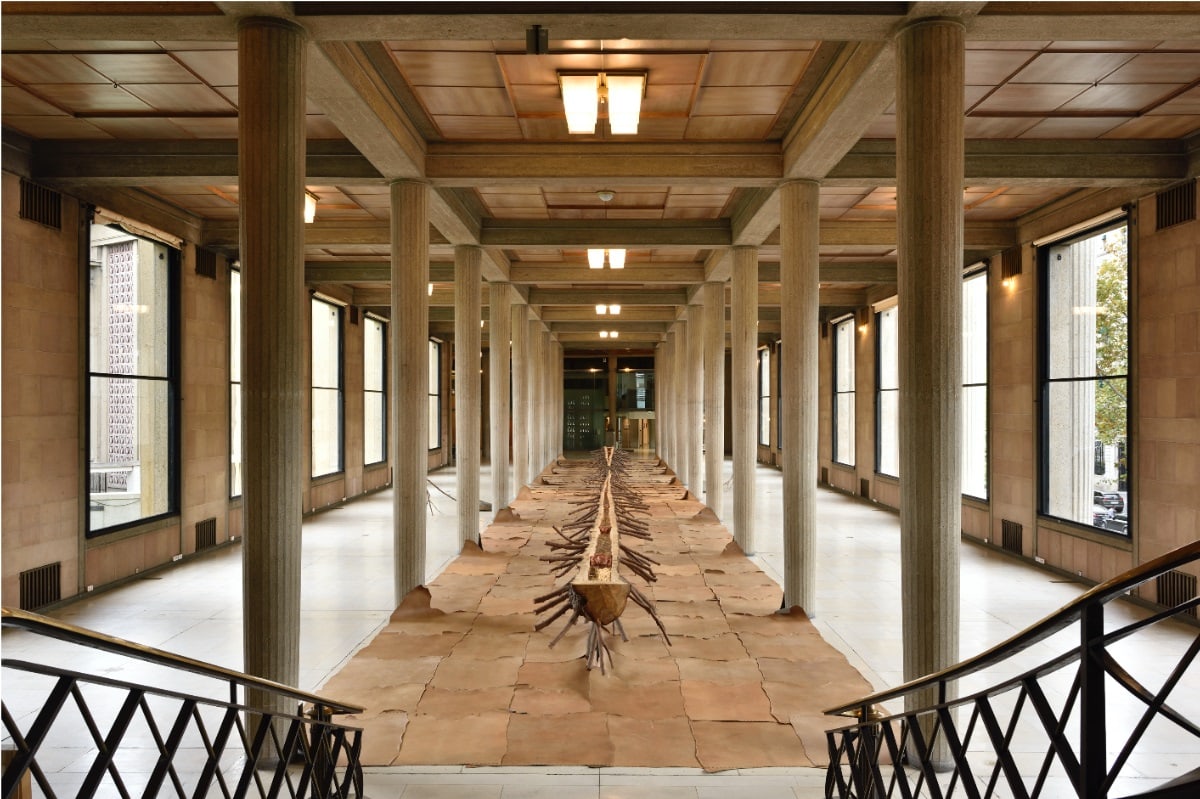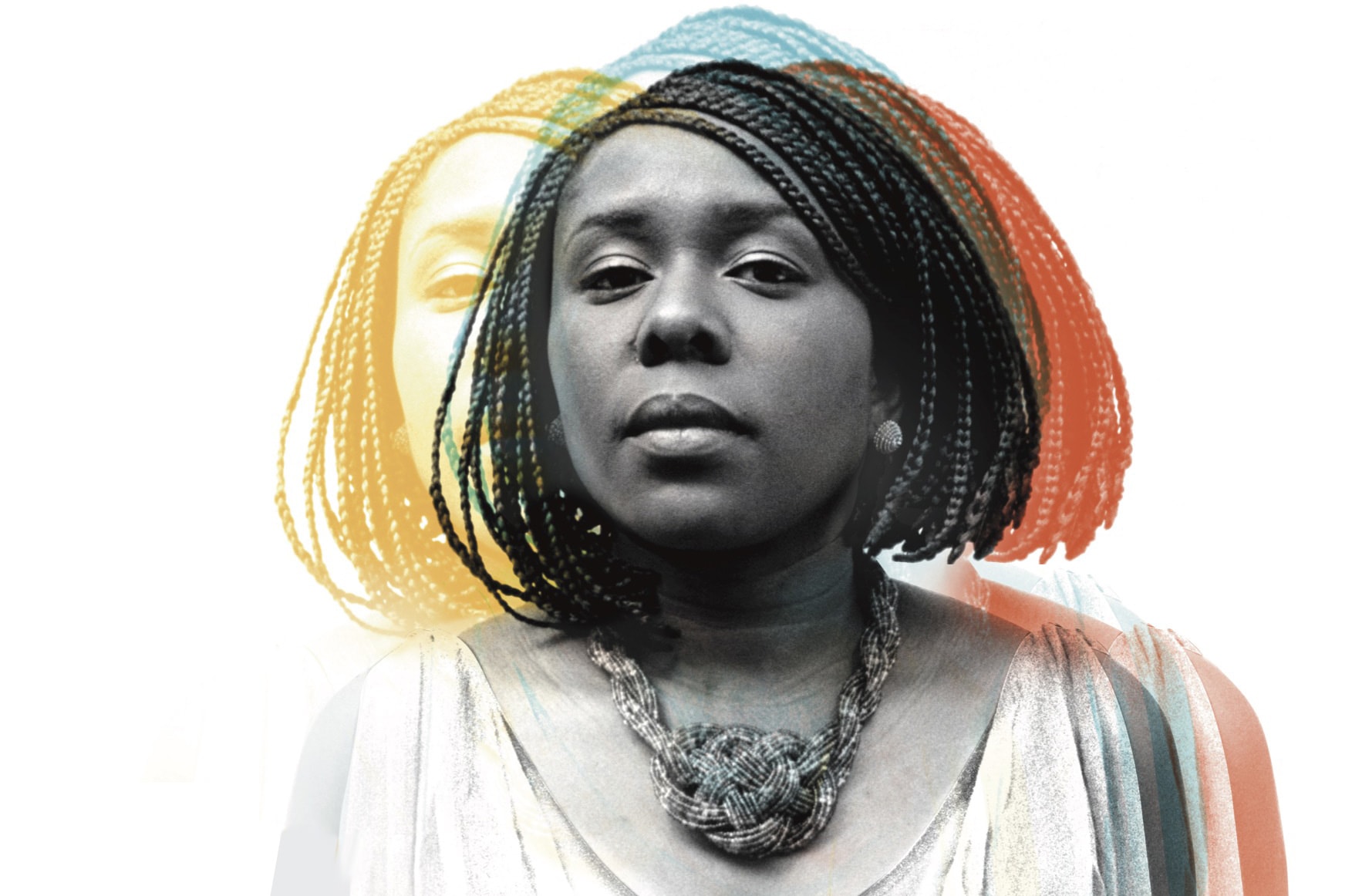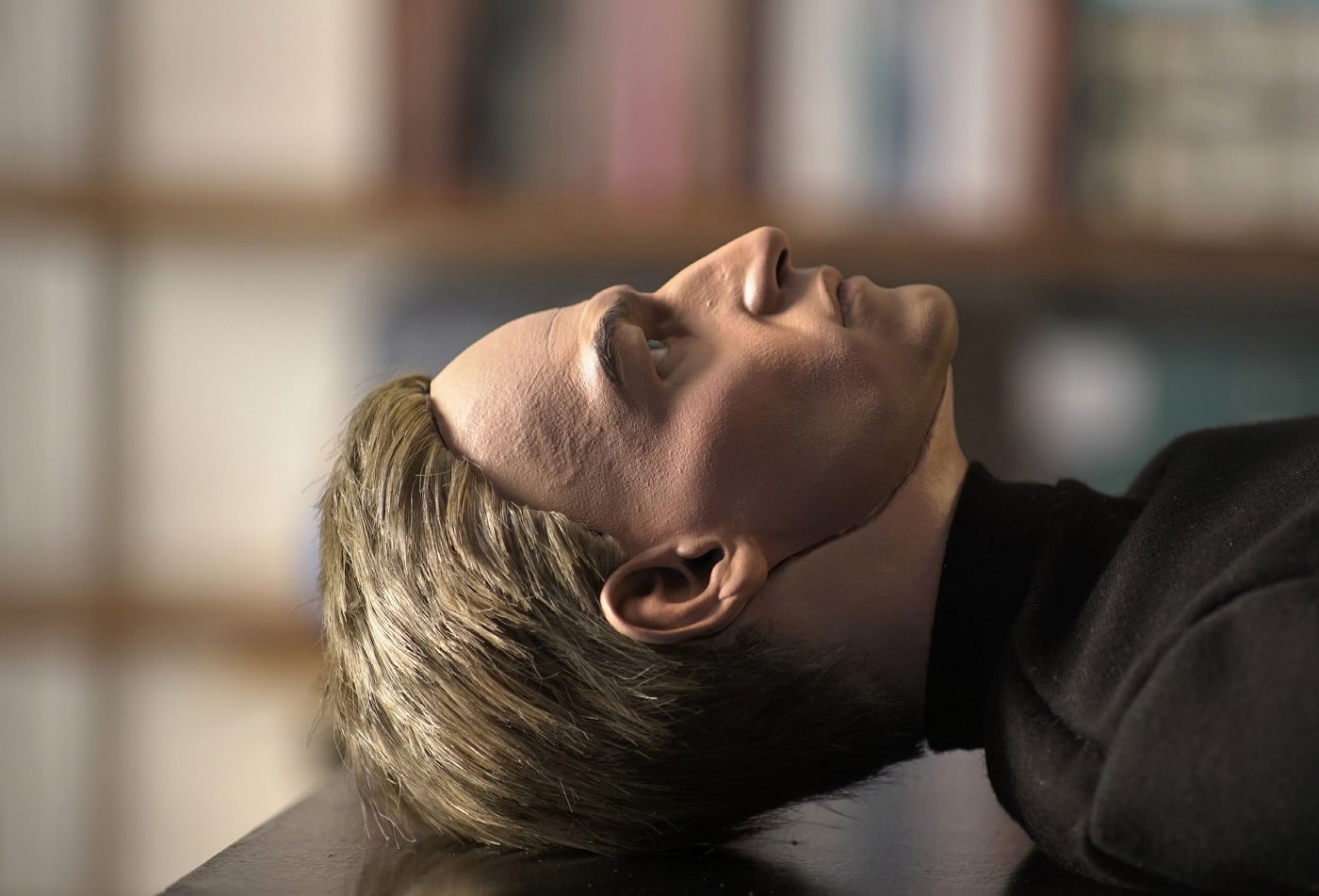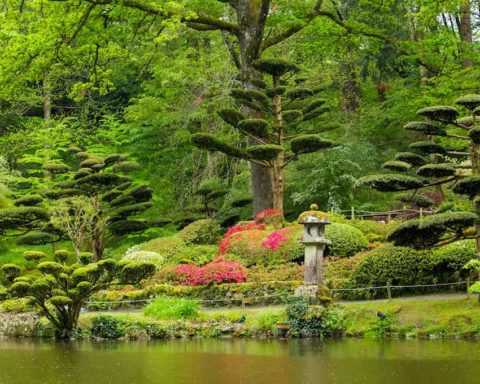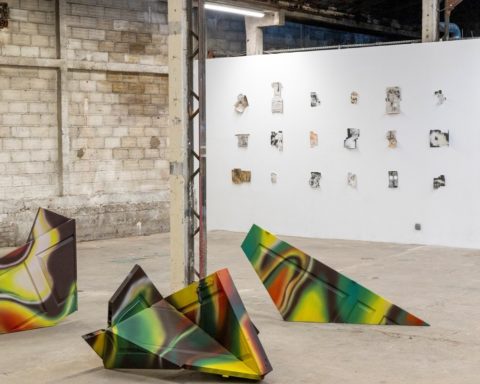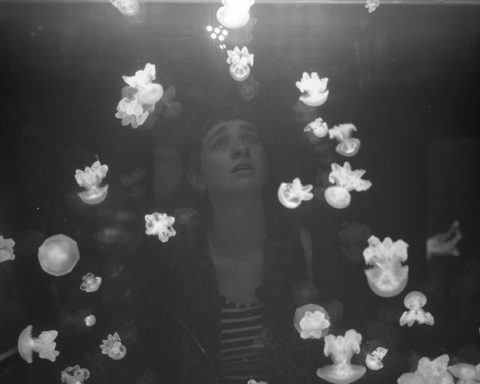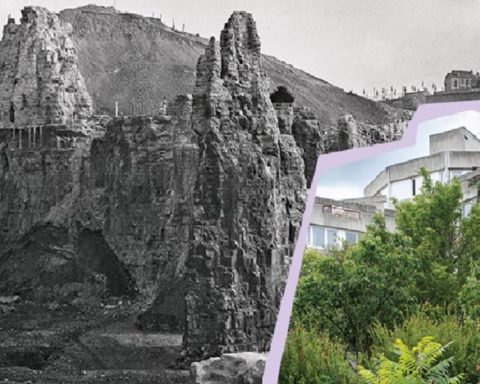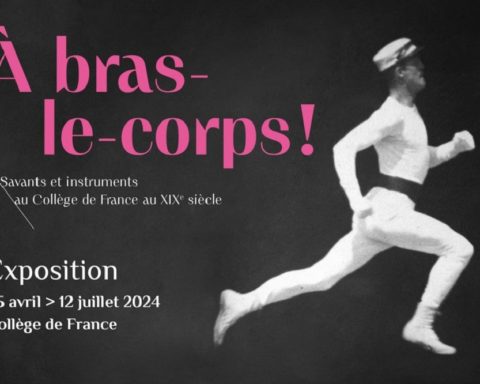As part of FIAC 2019, the Palais d'Iéna - Economic, Social and Environmental Council (EESC) invites Giuseppe Penone to the heart of the vast hypostyle hall and its majestic colonnades over seven metres high. For his first exhibition in Paris since 2013, organised in collaboration with the Marian Goodman Gallery, the artist has chosen to present the monumental work Linfa matrix (Matrix of sap) as well as two sculptures unveiled here for the first time.
For Linfa matrixThe artist intervened on the history of a tree by digging in the wood the volume equivalent to eighty years of growth. A strong echo to the EESC's commitment to the environment and to the celebration of the eightieth anniversary of Auguste Perret's architectural masterpiece.
Giuseppe Penone considers Linfa Matrix as a form of animal nature, evoking an open book, "a long sacrificial altar" or even "a long, slender boat that furrows the space pushed by the force of the branches". This exceptional sculpture in two parts of almost twenty metres each, created from a century-old coniferous tree from the Vallée des Merveilles in the French Alps, is the result of a multiplicity of gestures.
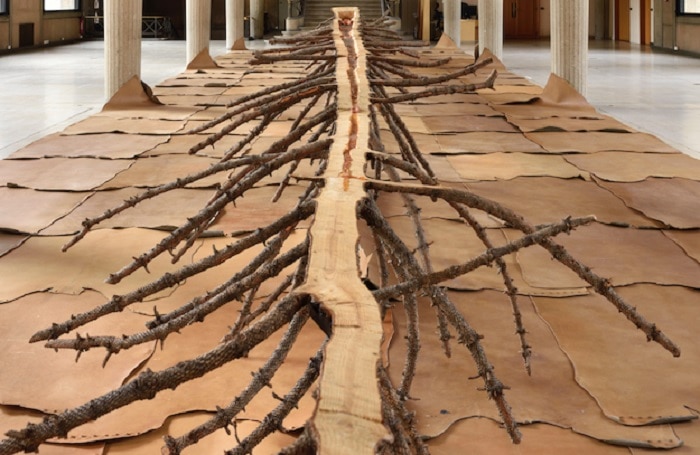
Photo credit: Rebecca Fanuele © Palais d'Iéna, architect Auguste Perret, UFSE, SAIF/Courtesy Archivio Penone and Marian Goodman Gallery, New York, Paris, London
Sap Matrixby Giuseppe Penone
"The trunk of an overturned fir tree loses part of its vegetal nature and suggests a different, animal nature; it is reminiscent of a caterpillar. Its trunk is half divided along its twenty-five meters and exposed open like the pages of a book, revealing the section of all its growth rings, about one hundred. Its branches, from its very bushy layers, cut about eighty centimetres from the trunk, seem to move in the void. They are legs that stir the air, like the oars of an ancient galley stirred the sea water. A long, slender boat that moves through the space pushed by the force of the branches. The branches that, swaying in the wind, have pushed the tree towards the light year after year, floor after floor, for a hundred seasons, rowing against the force of gravity and raising the trunk, now surround it like a sacrificial altar forty meters long. The two halves of this very long table have been hollowed out. From their interior, the shape that the tree had when it was eighty years old has been removed. One might think that the naked tree is in the forest and that it has had only twenty clothes removed, twenty years of growth.
Its absence, like an imprint, of a body rising from sleep, reminds one of a river bed. A river of sap flows through it, filling its emptiness and underlining the horizontality to which the implacable force of gravity subjects us all. The amber-red of the sap fills the matrix left by the tree and animates it, its glow recalls the vital turgidity of the body that inhabited it. Its perfume invades and dilates the lungs, which in turn become matrices of the forest's space.
Giuseppe Penone, 2009 "
This text was first published in the catalogue of the Giuseppe Penone exhibition. Matrice de sève, which was held at the Ecole nationale supérieure des beaux-arts de Paris, from 14 May to 17 July 2009.
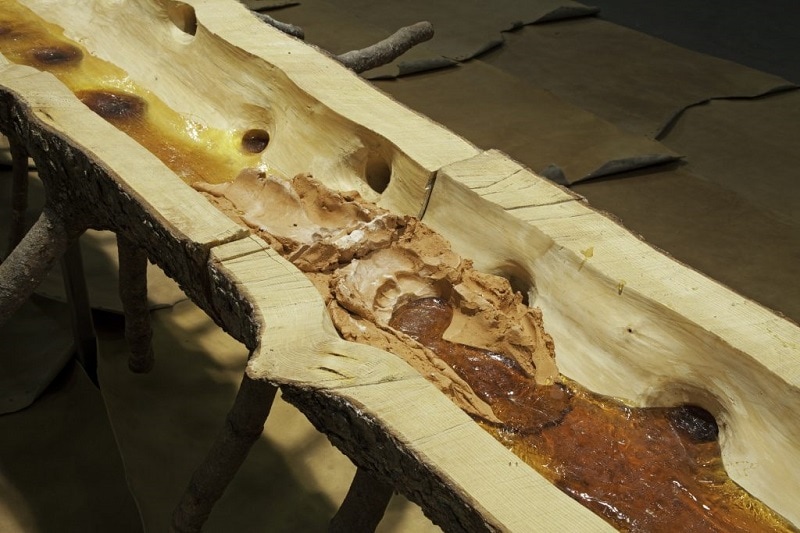
Why not enjoy unlimited reading of UP'? Subscribe from €1.90 per week.
Sap matrixby Laurent Busine
- "Gimpele, do men exist?
- No, men don't exist.
- What's there?
- What exists: a body without eyes, a mouth that does not speak and a heart that does not beat.
- And yet, Gimpele, we believe that the body sees, the mouth speaks, the heart beats.
- You see, Leyele, it is because our form is reflected in the pond, because the waters speak, the trees bloom.
- Oh, tell me, Gimpele, a tree, what does he see in his dream?
- Leyele, I'm a tree myself, and in my dream, there's you.
Moses Kulbak "
Can one look into the depths of a body other than through a metaphor? The body is not only what I live in or what I shelter: this mass more or less made up of muscles, flesh, bones and water. Disease continues its work there; accidents, their brutality, as much as the food I eat and the pleasures I consume give it form.
One is stuck there as in a narrow house in which one holds a living room; it is the volume that serves as my citadel and which disappears when the memory, alone, remains.
The sculptor was looking for a tree. He went to the Valley of Wonders and recognized the one he had in mind: a lone fir tree. The tree, which was soon to be felled for safety reasons, had kept all its branches from its base to its top. Giuseppe Penone knew, not which tree he wanted to discover, but what shape, height and type of branches the conifer should have. All this was precise and clear, clear in the image that already existed in him and that he wanted to concretize.
He knew, moreover, that he would need all these staggered branches so that the severed trunk would rest on these numerous legs like a somewhat monstrous animal, disembowelled, supported by green, black, grey, rough limbs.
After having it cut down, he took the tree, piece by piece, back to his workshop; the parts of the trunk were still covered with their branches cut down to about eighty centimetres. It was disturbing because the powerful mass of the tree formed a considerable heap, holding an enormous volume, and also because the intertwined branches created an indistinct interlacing which gave the impression that the whole thing could move with the slowness or surprise of the seemingly sleeping animals.
Giuseppe Penone sawed the trunks from the middle and each part then presented a clear surface more or less wide, more or less narrowed, elongated like a table, like a workbench, like a worktop. The succession of growth rings from the centre to the black bark could be seen precisely; from the last - the youngest year - thin as a thread to the first - the oldest year - wide as half a wheel. Then he carved into the heart of the table, blew out splinters, ripped out pieces, removed whole sections of wood, removed year after year until, having preserved a certain thickness on each of the outer edges and determined the volume to be extracted, he revealed a cavity, a ring, a smooth skin, hitherto hidden in the secret of the old tree, and he stripped it along the tens of metres of the size of the fir tree, wide at its base, narrow at its top.
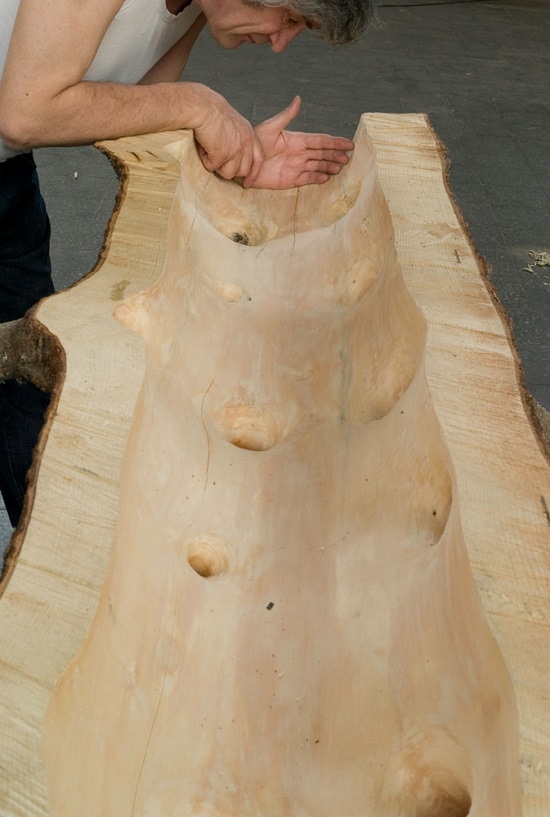
Photo © Archivio PenoneCourtesy Archivio Penone and Marian Goodman Gallery, New York, Paris, London
This required patient work, cautious gestures, repeated attention so as not to injure, bruise by clumsiness or haste this ancient, fine, soft and fragile mucous membrane. For the shape that this vaguely cylindrical skin reveals is not uniform, but marked by pits, hemmed caves, rounded domes, folds, soft festoons, rounded crevices, swollen curves.
The sculptor also inserted his gouges, scissors and knives into the long, narrow, deep holes of the elongated branches and uncovered the openings and round holes. With meticulousness, prudence, patience, and delicacy - tenderness, to say the least - he also worked out the sharpness, the flesh, the wood, the branch pressed into the material like a cylinder, with a finger that slips in and out of the flesh, the lips. Giuseppe Penone hollowed out the tips of the branches that form tunnels in the body and hollowed them out. The tree has kept all the stages of its growth, down to the most minute or insignificant: such and such a branch has been broken, such and such a branch has atrophied.
The sculptor dislodged from the mass the tiny and the great memories of this singular yet common life in this century, when humanity was at war or at peace, but men and women were making children, feeding and educating them, helping them to grow up, to become adults, to keep memories - big or small - and to procreate.
The work is slow and gentle because what the sculptor removes is a large, heavy mass that is connected to the rest of the tree by the life that produced it. It is a part of the memory of the tree that is removed to reveal another memory of the tree to the eyes: obscene depth of the open wound, of the nine orifices of the body, of the pearly hues, of the blond and pale mucous membranes; the interior, in short, where the eye ventures and sees the evidence, the shameless obviousness, of the pearly oblong form, open in the heart of the flesh, dripping with its secretions. For Giuseppe Penone has poured a liquid stream of red resin into the body of the tree; and from the outside, from the collected bark, it now runs through the valleys and the arms, the beds and the torrential slopes of the inside of the body, freer, calmer too; horizontal when, in his life, it was only vital pushed upwards; it now takes up the inescapable position of universal gravity.
The colour of the viscous resin is very close to that of the blood which coagulates when, escaping from the tortuous paths of the veins and arteries, it slowly freezes in reddish, brownish, blackish hues depending on the thickness of the scabs and bedsores. It flows through the white skin of the empty body like the blood that runs, nourishing and penetrating the flesh - and we call "dragon's blood" a red, dark colour made of resins. They are liqueurs of honey, gold, amber; red, garnet, carmine humours; fawn, coppery, golden, earthy liquids.
To fight against disinformation and to favour analyses that decipher the news, join the circle of UP' subscribers.
But this blond, smooth and wavy gap, which still palpitates under the light, is the fruit of the liquids that shaped it on the model of all the previous rings, including accidents, the avatars of growth : Moisture or drought, strong wind or calm clouds, the earth and pebbles where the roots have grown... It's a skin deposited in a pre-existing mould, forced by the obstinate sap that spreads the growth rings, pushes back the bark and raises the top of the tree: a considerable force, a colossal power that shaped this giant.
Like water that dislocates stones, undoes mountains and digs valleys, the fertile liquid makes the tree grow, the band towards the sky, slowly insinuating itself into it, spreading out the agglutinated flesh, gaining one interstice and then another in the heavy masses, creating faults, breaches that, little by little, open up in the growing body. The tree, in fact, keeps in its heart the precise shape of the ages it has known and, in this sense, one could say that it is constantly the matrix of its own added images. It holds the image of its first year, its second year, its third year and so on ... progressively, different and close according to the clemency or harshness of the seasons, and it keeps them invariably classified in the order of their succession: the tree in the secret of its life.
The sculptor Giuseppe Penone gives an image of it, extracts and adds to the tree what allows us to see the invisible present, existing in the heart of the wood by sawing it, hollowing it out, placing it on the structure of its branches, laying it down, filling it with resin, by closing the ends with earth, by marking this earth with the imprints of his own body, by affirming that his hands, his fingers, his face have worked on the creation of the work with empty traces, just as the old place of the tree is now empty: its soul, in its bosom. Understand the term "soul" in the sense that it designates the core - not visible - of a bronze statue, for example, enclosed in the material and which has, from the outside, a vague appearance; or again, the small piece of wood placed inside a violin, between two tables, and which makes the wood of the instrument sing. The open tree resounds like a storybook. Eyes plunge into its belly and discover its soul; placed on a carpet of tanned, brown cowhides, it contains the memory of a unique life, which has become, through the sculptor's work, exemplary of all those - vegetable, animal and mineral - that make up the face of the world at every moment. It is an oblong opening hollowed out of the woody mass: milky, pearly, pink and pale, surrounded, bristling with black stems; the nymphs, secret guardians of caves and springs.
Laurent Busine, 2010 "
This text was first published in the catalogue of the Giuseppe Penone exhibition. Des veines au ciel ouvertes, which was held in Belgium, Musée des Arts contemporains au Grand-Hornu, from 31 October 2010 to 13 February 2011. The version presented here differs slightly from the first one. This version will be published in the exhibition booklet Matrice di lifa (Matrix of sap) at the Palais d'Iéna-CESE in Paris until 27 October 2019.
At the Jena Palace, Linfa matrix is for the first time accompanied by two sculptures from the series Pensieri di foglie (2014 – 2017).
Placed in the centre of the hypostyle hall on either side of the columns, near the space where the two parts of the tree meet and where the visitor can walk, the bronze branches and leaves associated with stones naturally sculpted by a river appear as anthropomorphic silhouettes. As well as Linfa matrixthe works Pensieri di foglie reveal the memory of matter that usually escapes our perception and illustrate the interdependence of man and nature.
A short film specially designed for the exhibition and shown every day in the hemicycle of the Palais d'Iéna, documents the creative process of several of the artist's works, including Matrice di linfa.
An exhibition booklet and a numbered and signed artist's book (published in 35 copies) accompany the exhibition.
In parallel at the Galerie Marian Goodman, 79 rue du Temple, Paris 3e, a selection of drawings and a sculpture Pensieri di foglie related to the exhibition will be presented until October 24th.
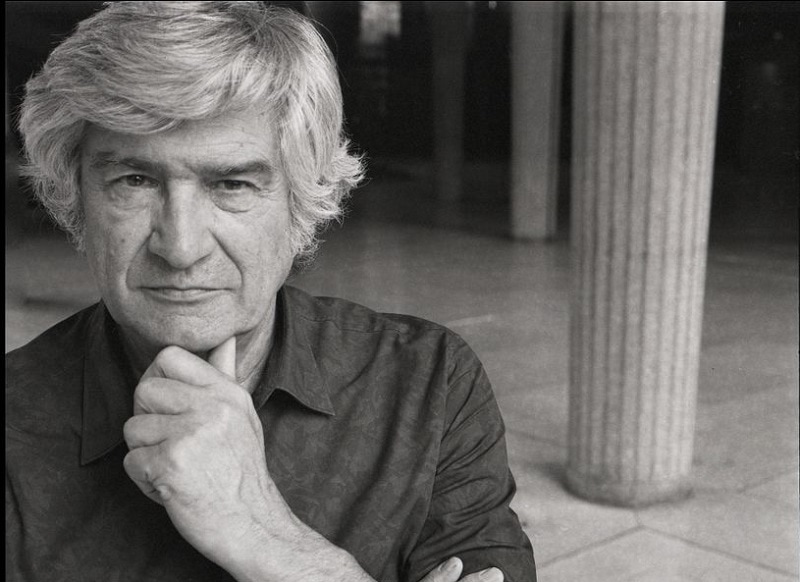
The artist Giuseppe Penone
Giuseppe Penone was born in 1947 in Garessio in Piedmont, Italy. He studied sculpture at the Accademia di Belle Arti in Turin before his work was noticed by Germano Celant and associated with the Arte Povera movement. As a sculptor, he is laureate of the prestigious Praemium Imperiale (2014). In 2007, he represented Italy at the 52nd Venice Biennale. The Musée national d'art moderne-Centre Pompidou devoted a major retrospective to him in 2004.
Giuseppe Penone lives and works in Turin. His work has also been shown in the most important international museums, and recently at the Saarland museum, Moderne Galerie Saarbrücken (current exhibition), Palazzo della Civiltà in Rome (2017), the Museum of Contemporary Art of Trento and Rovereto (MART) (2016), the Nasher Sculpture Center in Dallas (2015), the Musée Cantonal des Beaux-Arts in Lausanne (2015); at the Beirut Art Center (2014); at the Musée de Grenoble (2014). In recent years he has also installed his monumental sculptures in prestigious gardens such as the Yorkshire Sculpture Park in Wakefield (2018 -2019), the estate of Château La Coste in Le Puy Sainte Réparade (2017), the gardens of the Rijksmuseum in Amsterdam (2016), the Venaria Reale Park near Turin (2015), the Giardino di Boboli in Florence (2014) and the gardens of the Château de Versailles (2013).
The exhibition Linfaest matrix organised by the Economic, Social and Environmental Council (EESC) with the collaboration of the Marian Goodman Gallery. The Economic, Social and Environmental Council, France's third constitutional chamber, underlines, both through its work and the exhibitions it hosts, how culture must occupy a privileged place in public debate and continue to enrich the much-needed dialogue between citizens within organised civil society.
The exhibition, with free admission, is open every day until Thursday, October 24th from 11 am to 6 pm.
A small exhibition booklet and a numbered and signed artist's book (published in 35 copies) accompany the exhibition.
In parallel to the Marian Goodman Gallery, 79 rue du Temple, Paris 3e, a selection of drawings and a sculpture Pensieri di foglieen linked to the exhibition will be presented until October 24th.
To go further : Interview of Giuseppe Penone on France culture of 15 October 2019

